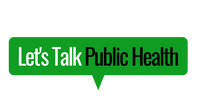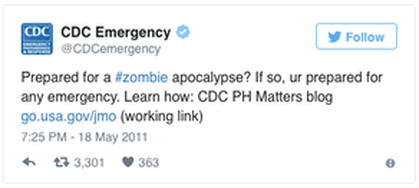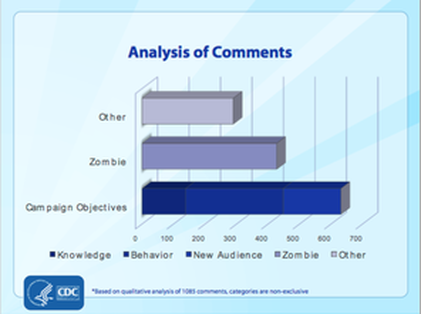CDC's Zombie Preparedness - A Great Example of Edutainment and Integrated Marketing Communications12/10/2017 Preparedness 101: Zombie Apocalypse
This case study reviews the Centers for Disease Control and Prevention (CDC)'s Zombie Preparedness, an example of a national public health edutainment campaign.
What started off with a blog post in 2011, has turned into an ongoing campaign to engage Americans around the importance of public health preparedness. There are now posters, shirts, a graphic novella, attendance at zombie-themed races and comic book conventions, video contests and partnerships with zombie genre franchises and authors. Background
Before this campaign began, CDC posted regularly about public health preparedness on its Public Health Matters Blog--getting an average of 80 page views per hour. These posts discussed hurricanes, tornadoes, and other natural and man-made disasters, and used key three messages: Get a kit, make a plan, and be informed. They also shared posts regularly on their Twitter and Facebook accounts.
As part of their usual social media content, CDC asked their followers on Twitter, "What are you prepared for?" Among the responses they received, "zombies" was repeated. They kept this in mind when preparing for the upcoming 2011 hurricane season. Content Planning and Creation
CDC decided to use their usual blog post messages, but within the context of a zombie apocalypse. They said: "If you're prepared for a zombie apocalypse, you're prepared for any emergency."
CDC created a blog post that stuck to this theme, but was also sure to relate back to natural disasters and other real-life emergencies. They were also sure to link to the other emergency preparedness resources on their website. They had three objectives:
To drive traffic to their blog post, CDC used an integrated marketing communications approach to devise a marketing and dissemination plan. They decided they would post to their Facebook and Twitter accounts, send out alerts to the GovDelivery listserv and RSS feed, and add a flash banner to the CDC Emergency website. They also chose to conduct media outreach before their launch, to give mainstream outlets a heads up about their zombie content. Marketing and Dissemination
To drive traffic to their blog post, CDC used an integrated marketing communications approach to devise a marketing and dissemination plan. They decided they would post to their Facebook and Twitter accounts, send out alerts to the GovDelivery listserv and RSS feed, and add a flash banner to the CDC Emergency website. They also chose to conduct media outreach before their launch, to give mainstream outlets a heads up about their zombie content.
Implementation
They did a soft launch on Monday, May 16, posting the blog and doing updates via email, RSS, and the CDC Emergency website homepage. After receiving light media attention on Tuesday, they did a full social media push on Wednesday, May 18. They also marketed the post via the main CDC website home and news pages.
Results
Within 10 minutes of their first tweet, the Public Health Matters blog servers crashed from high traffic--they got over 30,000 visitors. They were getting over 60,000 views per hour on Wednesday. The "Preparedness 101: Zombie Apocalypse" post got over 800,000 page views in one day, whereas a typical blog post on Public Health Matters was getting between 1,000-3,000 views per month. By the end, they had a total of 2,324,517 blog page views.
They got over 70,426 clicks on that first tweet. They also got 1,164,057 clicks to the blog from that tweet and 34,714 unique tweets about the blog post. They were trending on Twitter with #CDC and #ZombieApocalypse. On Facebook, they gained over 7,000 new fans in three weeks. By May 22, they had about 867 engagements (likes, comments, shares), which were majority positive.
They also saw a 1,143% increase in traffic (140,000 page views) on the CDC Emergency website between May 16 and June 7 compared to the same time period in the previous year. Visitors to the blog were actually clicking through to get additional information and resources. CDC also got a large amount of earned media coverage from major news and media outlets (more than 3,000 articles and broadcasts), helping them reach an estimated 3.6 billion viewers in the first week. Evaluation
The $87 investment in stock photography CDC made for that initial blog post turned into a great campaign. There are mixed reviews as to whether or not the overall campaign has been successful at improving retention of emergency preparedness information or increasing intention to make a plan or get an emergency kit (see journal articles referenced below). However, the original blog post did achieve its three goals. Qualitative analysis of 1,085 comments left on the blog demonstrated that CDC had reached its objectives in more than half of the people who visited the blog and read it.
References
0 Comments
Your comment will be posted after it is approved.
Leave a Reply. |
�
Learn about our blog submission guidelines. >>
The views and opinions expressed by individual authors on this blog are their own and do not necessarily reflect the official policy or position of Let's Talk Public Health.
Categories
All
|
|
Highlights
Explore
Connect
|
© 2024 Let's Talk Public Health, LLC. All rights reserved. | View our Privacy policy | Terms of service | Disclaimer | Editorial policy.





 RSS Feed
RSS Feed